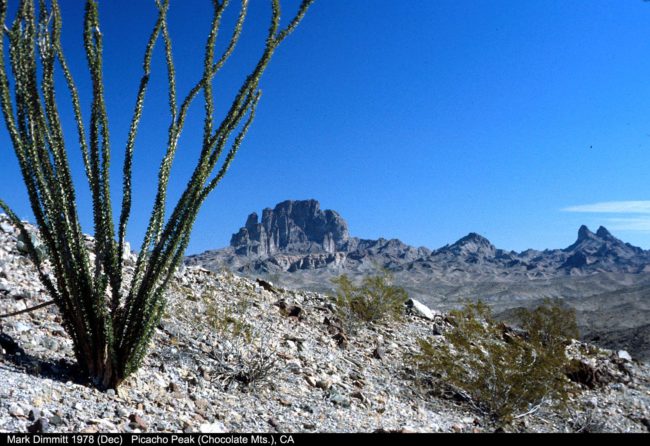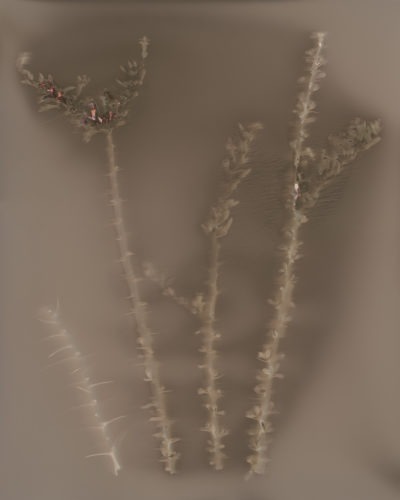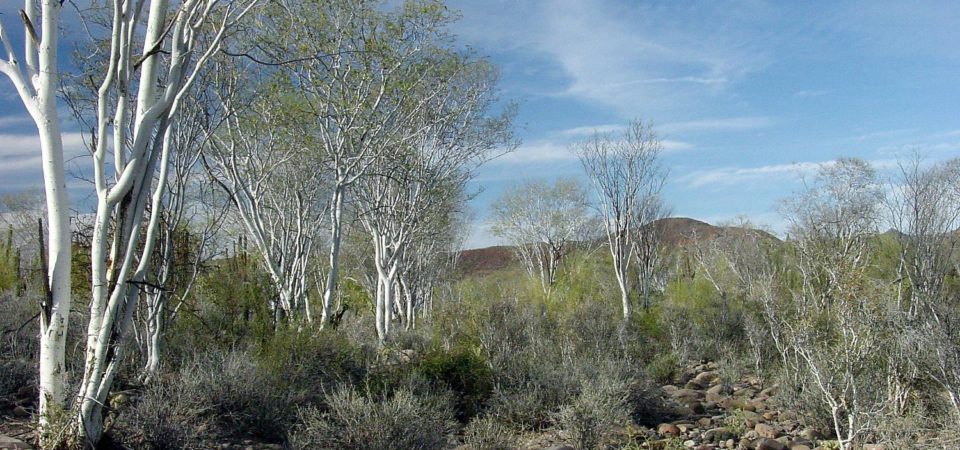Have you ever tried looking for shade in the desert only to find that the plants are unable to fully block the intense sunshine? What might feel like a particularly unkind slight in your time of desperation, is actually an incredible adaptation of some desert plants. Iain Robertson, a professor of landscape architecture at the University of Washington, first recognized this property of desert plants in the mid-1990s and began using the term diaphanous plants to describe them. Unlike plants from wetter habitats that boast leafy, dense canopies, diaphanous plants have such sparse stems and foliage you can often see right through them. In a land of intense sunlight and limited water, diaphanous plants have adapted to minimize transpiration and sun exposure. In adapting to their extreme conditions these plants are largely unique to the desert and hard to find in more forgiving systems. But in the Sonoran Desert they thrive, their odd forms defining the landscape.

As part of the 6&6 Project, biological photographer Charles (Chip) Hedgcock along with retired botanist/ecologist and horticulturist Mark A. Dimmitt are collaborating to showcase the diaphanous plants of the Sonoran Desert. Forged by the Next Generation Sonoran Desert Researchers network (N-Gen, www.nextgensd.com), the 6&6 Project is a collaboration between artists and scientists to explore the patterns and processes of the Sonoran Desert and Gulf of California. Using an alternative photo process to capture the odd forms of the diaphanous plants, Hedgcock and Dimmitt aim to introduce people to these plants in a way that features their incredible adaptations while maintaining the essence of the beauty they lend to the desert landscape.
Hedgcock is creating lumen prints of the diaphanous plants recommended by Dimmitt, which will be displayed alongside text explaining their adaptive functions. Hedgcock explains, the process of lumen prints is “done with expired photographic paper and long exposure in sun light.” The result? According to Hedgcock, “It almost looks like an x-ray kind of image, it’s an inverted image and you get these wonderful colors that come up from the interaction between the light sensitive emulsion and the parts of the plants.”
For Hedgcock, whose creative work previously tended towards more “traditional black and white silver gelatin work done in the dark room,” lumen prints provided an exciting divergence. “There were no cameras involved, it was a big, big change for me.” Hedgcock had just started experimenting with lumen prints when he became involved with 6&6. The project has “been a real wonderful opportunity and incentive to pursue this and work with this project. I knew it was cool when I saw my first examples of lumen prints, but it’s something that keeps getting more so for me. I still find it really wonderful and exciting and pleasing to me both visually and emotionally.”

Lumen prints are a highly experimental camera-less photographic technique that repurposes expired photographic paper. To create them, botanical specimens were collected and the plants sandwiched between a sheet of photographic paper and a sheet of glass. This assemblage is placed in direct sunlight for a period of time ranging from 4 hours to several days. The prolonged exposure to bright sunlight causes the silver salts in the emulsion of the photographic paper to oxidize. The Interaction of plant enzymes and atmospheric conditions with the photographic emulsion, along with the sunlight oxidized silver salts, all combine to create subtle colors and a uniquely detailed, negative image of uncommon beauty.
In presenting plant forms adapted to block minimal sunlight, it is both an illustrative and challenging process. For Hedgcock, this has meant a lot of experimenting: “It’s a little different with these plant forms because I’ve worked with leafy flowery things, so it’s been challenging working with these, all very experimental as well… I’ve had to do a little more specific experimentation with selecting plants and pressing plants and paper types and exposures.” When successful the lumen prints beautifully capture the unique forms of diaphanous plants. “Their form, the silhouette is very distinctive,” says Hedgcock, “It’s been interesting to think about this particular group of plants and to get to know them and to sort of see and appreciate this. You know what they look like, but through Mark I’ve come to appreciate the unique form that I hadn’t fully appreciated prior to this.”
Hedgcock’s experiments center on specimens from a list of species Dimmitt has identified that showcase the unique form of diaphanous plants. Dimmitt has been “growing some diaphanous plants [in his extensive greenhouses and gardens] and searching for harvestable or photographable specimens of others.”

The experimentation does not end with creating lumen prints, finding a way to digitize the images and display them has also required creative thinking. Creative thinking that both Dimmitt and Hedgcock have contributed to:
Mark came up with some way for people to actually experience it… maybe printing an image on a clear screen or something. That to me was a real interesting idea so I want to look into that. Printing like a big banner that would hang in the middle of the room that people can look through and see. See other people, other exhibits in the museum, get a real experience for looking through wonderful plant forms. It’s an abstract idea but it’s a cool one to think about and work with. He definitely had a hand in the creative notions for the display and getting points across to people.
How to best get points across to people is not a new question for Dimmitt, “Science functions on facts, logic, and rigorous analysis. However, much of my working life has been devoted to interpreting science to the general public. So I have not been isolated in an academic bubble, but have always been interacting with non-scientists who see the world in other ways.” Dimmitt sees the project as “a continuation of [his] career as a scientist and educator.” A career which has included academic degrees in ecology and botany along with a tenure at the Arizona-Sonora Desert Museum from 1979 through 2011, and an ongoing vocation as a horticulturalist. Throughout these pursuits Dimmitt has found that scientific understanding can amplify the beauty of the natural world. He explains, “I have been growing plants for their beauty since childhood. Understanding the anatomy and ecology of plants from a scientific perspective enhances their esthetic appeal to me.” At the same time, Dimmitt recognizes that the lens of rigorous science does not always lend itself to connecting with the public:
One of my mentors, author/scientist Gary Nabhan, jolted me out of my rigorous scientific thinking when I was writing for the book A Natural History of the Sonoran Desert. He advised not to begin with a string of dry facts about the subject, but to lead with a story that grabs the reader’s interest. That was a revelation to me at the time, and began my transition into other ways of perceiving nature.
Dimmitt also “had considerable exposure to art as an alternative means of appreciating nature” through the Art Institute at the Arizona-Sonora Desert Museum, which “is devoted to exhibiting and teaching about nature art, and was founded specifically to complement the museum’s more scientific exhibits.” Ultimately, Dimmitt concludes, for him “collaborating on an art project seems quite natural.”

Even with a collaboration that “seems quite natural” it still requires time, work, and –maybe most importantly for two self-described introverts– communication. As Dimmitt explains, “Neither one of us is particularly communicative, so we were slow in getting started.” Hedgcock echoes this in his description of the early stages, “we’re both kind of quiet and we’re used to working with other people but a lot of our work is inside our heads rather than outward… so it’s been a get to know each other kind of thing and that’s been part of the process too. Getting to know each other.” As they have built up their collaboration they have found that they are “both easy-going and get along well.” Which isn’t to say that they don’t disagree or bring different perspectives to the project, but that resolving those differences has “gotten smoother”. Hedgcock points to their different approaches to photography as an example of how “coming together and understanding each other’s aesthetic has gotten easier over time.” But that has taken work. Hedgcock admits, “When I got asked to submit work and participate I knew it would be a fun and cool thing to do. But I didn’t anticipate at the time how much actual work was going to be involved.”
As the products of that work are beginning to come to fruition, it is clear that the collaboration fostered by Dimmitt and Hedgcock will provide an opportunity for people to not only view, but also experience and more fully understand, the beautifully adaptive form of diaphanous plants.
This project is part of the 6&6 collaboration introduced at the end of April. You can find out more about 6&6 here. The MAHB will be featuring additional scientist-artist partnerships from the collaboration in the coming weeks.
The above post is through the MAHB’s Arts Community space –an open space for MAHB members to share, discuss, and connect with artwork processes and products pushing for change. Please visit the MAHB Arts Community to share and reflect on how art can promote critical changes in behavior and systems and contact Erika with any questions or suggestions you have regarding the space.
MAHB Blog: https://mahb.stanford.edu/creative-expressions/unusual-form-diaphanous-plants/
The views and opinions expressed through the MAHB Website are those of the contributing authors and do not necessarily reflect an official position of the MAHB. The MAHB aims to share a range of perspectives and welcomes the discussions that they prompt.
